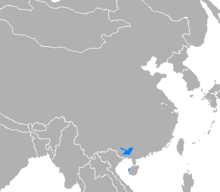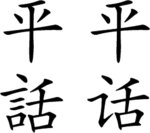Pinghua
| Pinghua | |
|---|---|
| 平話 / 平话 | |
|
Pinghua written in Chinese characters | |
| Native to | China |
| Region | Guangxi |
Native speakers | over 2 million (2016)[1] |
| Dialects | |
| Language codes | |
| ISO 639-3 |
None (mis) |
| ISO 639-6 |
(none) |
| Glottolog |
ping1244 |
 | |
| Pinghua | |||||||||||
| Traditional Chinese | 平話 | ||||||||||
|---|---|---|---|---|---|---|---|---|---|---|---|
| Simplified Chinese | 平话 | ||||||||||
| Cantonese Yale | Pìhng Wá | ||||||||||
| Hanyu Pinyin | Píng Huà | ||||||||||
| |||||||||||
| Alternative Chinese name | |||||||||||
| Traditional Chinese | 廣西平話 | ||||||||||
| Simplified Chinese | 广西平话 | ||||||||||
| Cantonese Yale | Gwóngsāi Pìhng Wá | ||||||||||
| Hanyu Pinyin | Guǎngxī Píng Huà | ||||||||||
| |||||||||||
Pinghua (simplified Chinese: 平话; traditional Chinese: 平話; pinyin: Pínghuà; Yale: Pìhng Wá; sometimes disambiguated as 廣西平話/广西平话) is a group of related varieties of Chinese spoken mainly in parts of the Guangxi Zhuang Autonomous Region, with some speakers in Yunnan province. Pinghua is a trade language in some areas of Guangxi, where it is spoken as a second language by speakers of Zhuang languages. Some speakers of Pinghua are officially classified as Zhuang, and many are genetically distinct from the Han majority of Chinese speakers.[2] The northern subgroup of Pinghua is centered on Guilin and the southern subgroup around Nanning. Southern Pinghua has several notable features such as having four distinct checked tones, and using various loanwords from Zhuang, such as the final particle wei for imperative sentences.
History and classification
Language surveys in Guangxi during the 1950s recorded varieties of Chinese that had been included in the Yue dialect group but were different from those in Guangdong. Pinghua was designated as a separate dialect group from Yue by the Chinese Academy of Social Sciences in the 1980s[3] and since then has been treated as a separate dialect in textbooks and surveys.[4] However, it is not at present noted in Ethnologue.
Since designation as a separate dialect group, Pinghua has been the focus of increased research. In 2008 a report by the Chinese Academy of Social Sciences of research into Chinese varieties noted an increase in research papers and surveys of Pinghua, from 7 before the 1987 publication of the Language Atlas of China based on the revised classification, and about 156 between then and 2004.[5]
In the 1980s the number of speakers was listed as over 2 million.[6]
Pinghua is divided into two mutually unintelligible subgroups:[1]
- The northern subgroup (Guìběi 桂北) is spoken in northern Guangxi, around the city of Guilin, in close proximity with Southwest Mandarin dialects.
- The southern subgroup (Guìnán 桂南) is spoken in southern Guangxi, around the city of Nanning. These varieties form a dialect continuum with Yue varieties spoken in that part of Guangxi (excluding enclaves of Cantonese, such as in Nanning).[7] Yu Jin subdivides this group into three types:[8]
- Yongjiang, spoken along the Yong River around Nanning.
- Guandao (官道 "official road"), spoken to the east of Nanning in Laibin and the counties of Heng and Binyang, around the road to the Southwest Mandarin-speaking city of Liuzhou.
- Rongjiang, spoken along the Rong River to the north of Liuzhou.
Phonology
Nanning Pinghua has a voiceless lateral fricative [ɬ] for Middle Chinese /s/ or /z/, for example in the numbers /ɬam/ "three" and /ɬi/ "four".[9][10] This is unlike Standard Cantonese but like some other Yue varieties such as Taishanese.
Tones
Southern Pinghua has six contrasting tones in open syllables, and four in checked syllables,[11] as found in neighbouring Yue varieties such as the Bobai dialect:
| Tone name | Level píng 平 |
Rising shàng 上 |
Departing qù 去 |
Entering rù 入 | |
|---|---|---|---|---|---|
| Upper yīn 陰 |
高 | 52 or ˥˨ | 33 or ˧˧ | 55 or ˥˥ | 5 or ˥ |
| 低 | 3 or ˧ | ||||
| Lower yáng 陽 |
高 | 21 or ˨˩ | 24 or ˨˦ | 22 or ˨˨ | 23 or ˨˧ |
| 低 | 2 or ˨ | ||||
The split of the lower entering tone is determined by the initial consonant, with the low rising contour occurring after sonorant initials.[12]
Anthropological
Genetically, Pinghua speakers have more in common with non-Han ethnic minorities in southern China than with other Han groups.[2]
References
- 1 2 Chappell, Hilary; Li, Lan (2016). "Mandarin and other Sinitic languages". In Chan, Sin-Wai. The Routledge Encyclopedia of the Chinese Language. Routledge. pp. 605–628. ISBN 978-1-317-38249-2. p. 624.
- 1 2 Pinghua population as an exception of Han Chinese's coherent genetic structure http://www.springerlink.com/content/e803426681664g43/
- ↑ 现代汉语 "Modern Chinese" ISBN 7-04-002652-X page 15
- ↑ Kurpaska, Maria (2010). Chinese Language(s): A Look Through the Prism of "The Great Dictionary of Modern Chinese Dialects". Walter de Gruyter. pp. 55–56, 76. ISBN 978-3-11-021914-2.
- ↑ cass report by 王宏宇 (in Chinese), April 2008
- ↑ 现代汉语 "Modern Chinese" ISBN 7-04-002652-X page 21
- ↑ de Sousa, Hilário (2016). "Language contact in Nanning: Nanning Pinghua and Nanning Cantonese". In Chappell, Hilary M. Diversity in Sinitic Languages. Oxford University Press. pp. 157–189. ISBN 978-0-19-872379-0. p. 162.
- ↑ de Sousa (2016), p. 160.
- ↑ Yan, Margaret Mian (2006). Introduction to Chinese Dialectology. LINCOM Europa. p. 204. ISBN 978-3-89586-629-6.
- ↑ http://www.glossika.com/en/dict/vocab/numbers.htm#pinghua
- ↑ Tan, Yuanxiong 覃远雄; Wei, Shuguan 韦树关; Bian, Chenglin 卞成林 (1997). Nánníng Pínghuà cídiǎn 南宁平话词典 [Nanning Pinghua Dictionary]. Nanning: Jiangsu jiaoyu chubanshe. p. 6. ISBN 978-7-5343-3119-0. (part of the Great Dictionary of Modern Chinese Dialects, edited by Li Rong)
- ↑ Lee, Gina (1993). Comparative, diachronic and experimental perspectives on the interaction between tone and the vowel in Standard Cantonese (PDF) (Ph.D. thesis). Ohio State University. pp. 75–76.
Further reading
- Xie Jianyou [谢建猷], et al. 2007. Studies on the Han Chinese dialects of Guangxi [广西汉语方言研究]. Nanning: Guangxi People's Publishing House [广西人民出版社].
